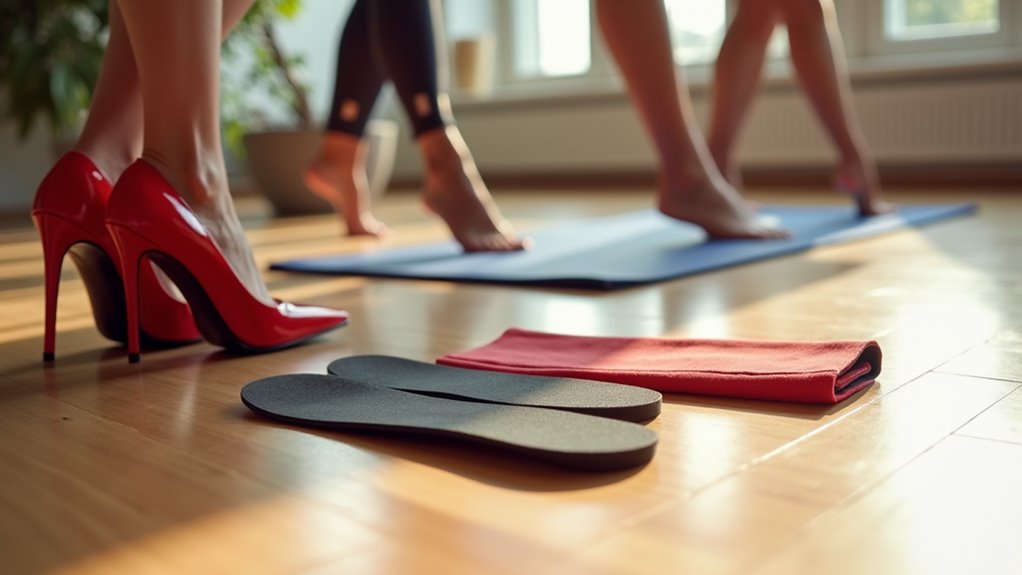There may be products. Products are independently selected by our editors. We may earn an affiliate commission from the links with no charge to you, example: as Amazon Affiliate.
To prevent back pain from stilettos, we’ll need to optimize our biomechanics through seven key areas. Let’s start with selecting supportive heel designs featuring contoured footbeds and shock-absorbing materials. We must master proper walking technique by engaging our core and taking shorter steps while maintaining vertical alignment from shoulders to hips. Building core strength, implementing smart heel rotation schedules, and perfecting our standing position are crucial. We can’t forget to take regular movement breaks and perform targeted stretches before and after wear. These evidence-based strategies will transform how our bodies respond to high heels.
Key Takeaways
- Choose heels under 2 inches for daily wear and incorporate shock-absorbing materials to minimize spinal stress and joint pressure.
- Practice proper walking technique with engaged core muscles and shorter steps to maintain balance and reduce lower back strain.
- Alternate between different heel heights throughout the week and schedule rest days to prevent muscle fatigue and tendon shortening.
- Perform ankle circles, calf stretches, and hamstring stretches before wearing heels to enhance flexibility and promote alignment.
- Build core strength through planks, bridges, and pelvic tilts to improve postural stability and reduce back pain while wearing heels.
Choose Supportive Heel Designs
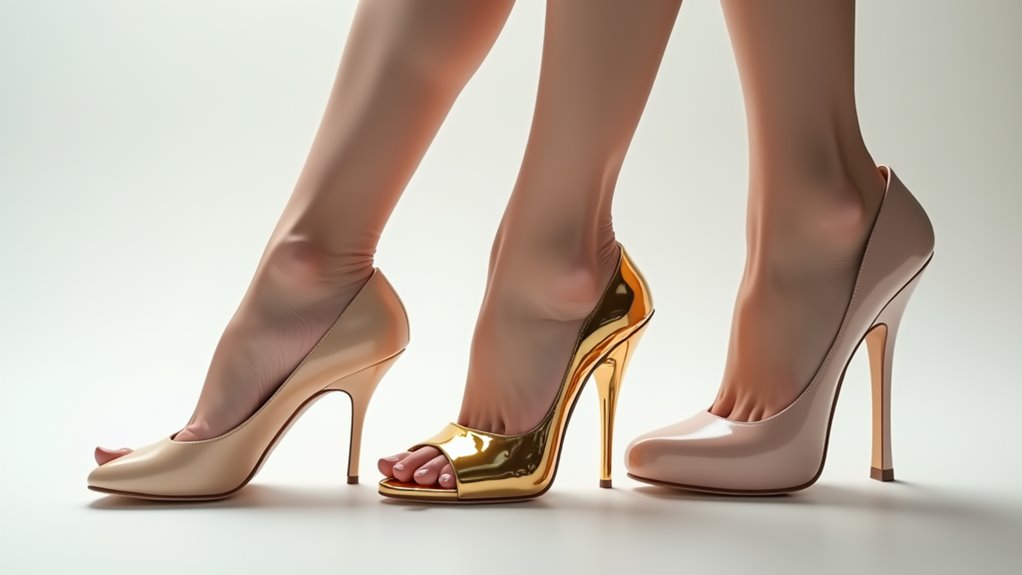
When it comes to preventing back pain while wearing stilettos, selecting supportive heel designs is crucial for maintaining proper biomechanics. We’ll help you choose supportive heel designs that minimize strain on your musculoskeletal system while maintaining style.
Let’s focus on the structural elements that matter most. We recommend opting for heels with a moderate height combined with a thicker platform, as this configuration optimizes weight distribution across the foot. To prevent back pain effectively, look for stilettos featuring contoured footbeds with built-in arch support, which helps maintain proper spinal alignment during wear.
The integration of shock-absorbing materials is essential for spinal health. We suggest selecting styles that incorporate cushioning technologies in both the heel and ball of the foot. Additionally, ensure your stilettos include adjustable straps or lacing systems, as these features secure your foot in the optimal position. This proper positioning reduces unnecessary stress on your back and helps maintain natural biomechanical alignment throughout the day. Modern comfort technology heels offer innovative features specifically engineered to reduce back strain while walking. By prioritizing these supportive design elements, we’re addressing the root causes of heel-related back discomfort while preserving the elegance of stiletto wear.
Master Your Walking Technique
Although wearing stilettos requires significant adjustments to natural gait patterns, mastering proper walking technique can substantially reduce back strain and improve overall stability. We’ll help you develop a biomechanically sound approach to walking in high heeled shoes that protects your spine and enhances your confidence.
Let’s start with engaging your core muscles while walking. This fundamental adjustment helps maintain proper posture and redistributes weight more effectively throughout your kinetic chain. We recommend practicing the heel-to-toe rolling motion, where you first make contact with the ground using your heel before transitioning smoothly to your toes. This technique helps alleviate excessive pressure on your forefoot and reduces spinal compression.
To further protect your back, we emphasize taking shorter steps rather than longer strides. This modification provides better balance control and reduces stress on your lower back muscles. Begin practicing on flat, stable surfaces before attempting more challenging terrains. Additionally, incorporating regular ankle and foot-strengthening exercises into your routine will improve proprioception and stability. These targeted exercises enhance your body’s ability to maintain proper alignment while wearing stilettos, reducing the risk of both acute and chronic back pain.
Build Core Strength
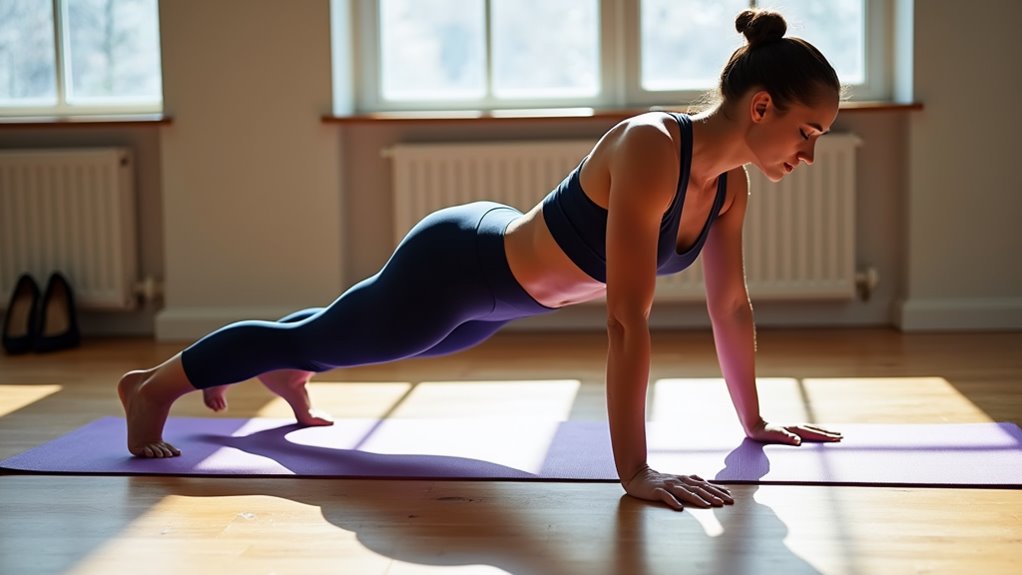
We can significantly reduce the strain of stilettos through targeted core-strengthening exercises like planks, which create a stable foundation for balanced heel walking. Our core muscles act as natural shock absorbers, distributing the pressure from high heels more evenly throughout our skeletal system during daily activities. By developing stronger abdominal and lower back muscles, we’re establishing an internal support system that helps maintain proper spinal alignment and minimizes the biomechanical stress that stilettos place on our bodies. Creating a comfort-wellness connection through proper core training helps promote overall physical wellbeing while wearing heels.
Planks Support Heel Balance
Since maintaining balance in stilettos requires whole-body stability, strengthening your core through plank exercises becomes essential for preventing back strain and improving heel control. When we practice planks regularly, we’re activating multiple muscle groups that support your back and enhance postural alignment while wearing high heels.
Let’s focus on incorporating various plank positions into our workout routine. Standard planks target the deep abdominal muscles that stabilize your spine, while side planks develop the lateral core strength needed for navigating uneven surfaces in stilettos. We’ve found that stronger core muscles directly correlate with reduced lower back strain, helping to alleviate discomfort during extended periods of heel wear.
To maximize the benefits, we recommend holding planks for increasing durations and progressing to more challenging variations. The enhanced core stability we develop through consistent plank training translates into better balance and control when wearing stilettos. By strengthening these crucial muscle groups, we’re not just improving our ability to walk gracefully in heels – we’re creating a robust foundation that protects our spine and promotes proper biomechanical alignment.
Core Muscles Reduce Strain
Building on our plank foundation, targeted core strength training stands at the forefront of back pain prevention for stiletto wearers. Our core muscles act as a natural corset, providing crucial stability to the spine while distributing weight evenly across our frame when we’re elevated in heels. We’ll focus on exercises that specifically target these essential muscle groups.
To effectively reduce strain on our backs, we need to incorporate a variety of core-strengthening movements into our physical activity routine. Bridges and pelvic tilts are particularly effective, as they enhance our postural alignment and create a solid foundation for stiletto wear. When we strengthen these muscles, we’re better equipped to maintain proper form throughout the day.
Let’s understand the biomechanics: Our core acts as a stabilizing unit that counteracts the excessive forces high heels place on our lower back. By developing these muscles, we’re creating an internal support system that can sustain longer periods in stilettos without compromising our spinal health. We’ll experience improved balance, enhanced endurance, and significantly decreased risk of back strain – all critical factors for comfortable heel wear.
Stabilize Through Daily Activities
Three daily activities provide natural opportunities to strengthen our core while preparing the body for stiletto wear. By integrating these movements into our routine, we’re creating a foundation of stability that helps prevent back pain when wearing high heels.
| Activity | Core Benefit | Heel-Ready Result |
|---|---|---|
| Dance | Activates deep core muscles | Improves weight distribution |
| Yoga | Enhances postural awareness | Increases spinal stability |
| Sports | Builds functional strength | Better balance control |
We can maximize these activities by maintaining conscious core engagement throughout our daily movements. When we’re performing household tasks, working at our desk, or even standing in line, we’re presented with opportunities to activate our core muscles. This constant engagement helps distribute the load more evenly when we’re wearing high heels, reducing strain on our lower back. By practicing proper alignment during these everyday activities, we’re essentially training our bodies to better handle the biomechanical challenges that stilettos present. It’s about creating a strong foundation through deliberate movement patterns that translate directly to improved stability in heels.
Practice Smart Heel Rotation
We can minimize back strain from stilettos by implementing strategic rest days between heel wear, allowing our feet’s musculature and tendons to recover their natural alignment. When wearing heels, we’ll benefit from alternating between high stilettos and lower, more supportive options throughout the week to prevent Achilles tendon shortening and maintain proper spinal positioning. We should integrate walking shoes into our daily rotation, especially during commutes or extended walking periods, limiting stiletto wear to 3-4 hours per session to protect our biomechanical structure. Choosing shoes with supportive heel designs can significantly enhance comfort and reduce pressure on the lower back during wear.
Schedule Rest Day Intervals
Smart heel rotation stands as a crucial strategy for preventing back pain from stiletto wear. By implementing scheduled rest day intervals between high heel wear sessions, we’re allowing our feet and spine to recover from the intense pressure these shoes create. When we distribute weight evenly through alternating footwear choices, we’re actively protecting our musculoskeletal system from unnecessary strain.
Let’s focus on protecting our Achilles tendon, which can become shortened and stiff from constant heel elevation. By incorporating regular rest periods, we’re preventing this anatomical adaptation while maintaining optimal tendon flexibility. During these intervals, our feet can readjust to their natural positioning, reducing the risk of developing common foot deformities like corns, hammertoes, and bunions.
We recommend establishing a consistent rotation schedule that includes at least two rest days per week from stilettos. On these days, opt for supportive footwear that promotes natural foot mechanics. This biomechanical approach not only supports spinal health but also ensures our feet maintain their structural integrity. By following this systematic rest pattern, we’re creating a sustainable foundation for long-term foot and back health.
Mix High-Low Heel Choices
By incorporating a strategic mix of heel heights into your footwear rotation, you’re establishing a proactive approach to spinal health and foot mechanics. We recommend alternating between high and low-heeled shoes throughout your week to maintain optimal muscle balance and reduce strain on your lower back.
When we examine the biomechanics, wearing stilettos consistently can lead to shortened Achilles tendons and muscle imbalances that contribute to back pain. That’s why we suggest limiting high heels to specific occasions and incorporating shoes with heels under 2 inches for daily activities. This rotation helps relieve back pain by allowing your feet and spine to readjust to natural positioning.
Let’s focus on weight distribution: high heels alter your body’s natural alignment, but low-heeled shoes help restore proper posture and reduce muscle fatigue. We’ve found that implementing this high-low strategy provides crucial relief to your feet while preventing the development of chronic back issues. By maintaining this deliberate mix of heel heights, we’re not just addressing immediate comfort – we’re protecting your long-term spinal health and reducing the risk of developing foot-related complications.
Alternate Walking Shoe Times
A strategic rotation between stilettos and supportive walking shoes plays a crucial role in preventing back strain and maintaining proper foot mechanics. We recommend implementing a deliberate schedule to alternate between heel heights throughout your day, ensuring your physical well-being isn’t compromised by prolonged stiletto wear.
To avoid excessive back stress, we suggest keeping a pair of comfortable walking shoes at your workplace or in your bag. This allows for quick changes during breaks or after commuting, effectively reducing the cumulative impact on your spine. When selecting walking shoes, focus on models with substantial arch support and cushioning that properly distribute body weight across your feet.
We emphasize the importance of mindful transitions between different shoe types. Pay attention to how your feet and back respond to these changes, adjusting your walking pattern accordingly to maintain optimal biomechanical alignment. By consciously rotating between stilettos and supportive footwear, we can minimize the risk of developing chronic back pain while still enjoying fashionable heel options. Remember, consistent alternation between shoe types helps your musculoskeletal system recover and adapt to varying heel heights.
Perfect Your Standing Position
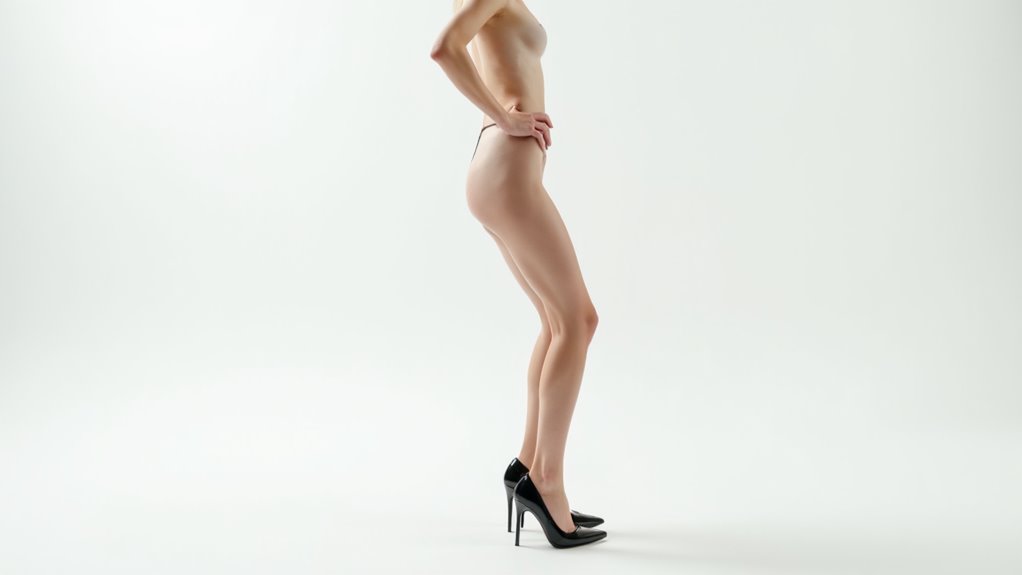
Proper standing position forms the foundation for preventing back pain while wearing stilettos. To keep your back healthy, we need to focus on optimal biomechanical alignment and weight distribution. Let’s start by maintaining vertical alignment of our shoulders directly over our hips, which helps prevent lower back pain by reducing unnecessary strain on our spinal column.
To distribute weight evenly and maintain stability, we’ll activate our core muscles while implementing these key positions:
- Place feet parallel to each other with weight balanced equally between both feet
- Keep ankles neutral, avoiding excessive arching that can destabilize the kinetic chain
- Position knees with a slight bend to optimize load distribution through the lower extremities
When we engage our core muscles properly, we create a natural support system for our lumbar spine. This muscular engagement works in conjunction with proper postural alignment to minimize compression forces on our intervertebral discs. Remember to maintain relaxed shoulders while standing, as tension in the upper body can translate into increased stress on the lower back. By focusing on these biomechanical principles, we’ll significantly reduce the risk of developing back pain from prolonged stiletto wear. For persistent comfort throughout long events, consider switching to cushioned formal shoes that provide better support while maintaining a professional appearance.
Schedule Regular Movement Breaks
Movement breaks serve as critical recovery intervals when wearing stilettos, preventing the cumulative stress that can lead to back pain. To maintain optimal spinal health, we’ll need to schedule regular movement breaks every 20-30 minutes throughout our day. These strategic pauses function like mini physical therapy sessions, allowing our bodies to reset and realign. Proper foot care products can enhance comfort during these essential movement intervals.
| Time Interval | Activity | Benefit |
|---|---|---|
| Every 20-30 min | Stand & stretch | Relieves spinal pressure |
| 2 min minimum | Walk in place | Enhances circulation |
| Throughout day | Targeted stretches | Reduces muscle fatigue |
Let’s incorporate these daily habits systematically by setting phone reminders or using break-tracking apps. During each pause, we’ll want to focus on movements that specifically counter the biomechanical strain of stilettos. Standing or walking for at least two minutes helps restore normal blood flow and muscle function. Additionally, performing gentle stretches targeting the lower back, hips, and legs effectively counteracts the postural adaptations our bodies make while wearing high heels. By consistently implementing these movement breaks, we’re actively working to prevent back pain and maintain healthier alignment throughout our day.
Stretch Before And After Wear
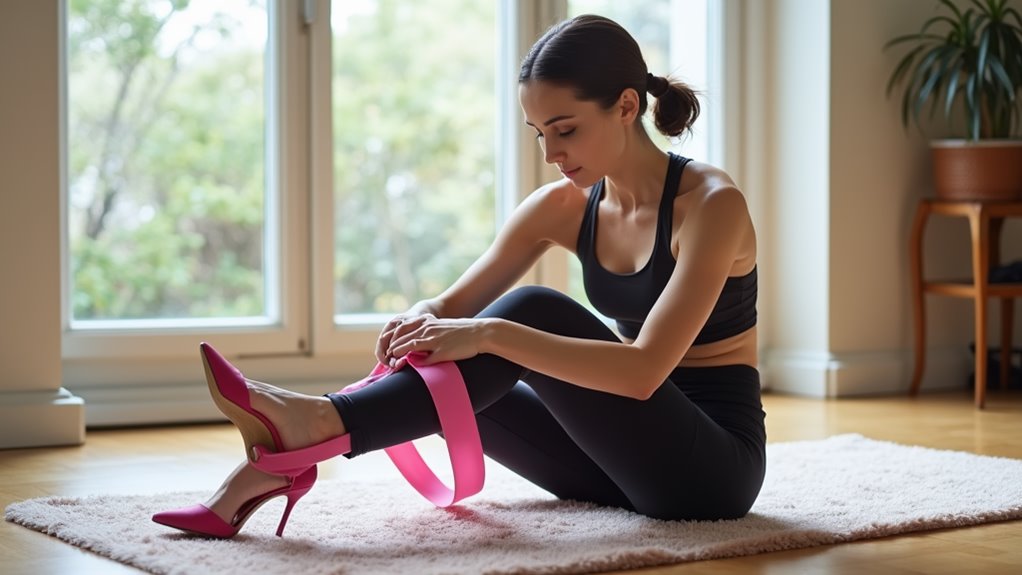
Strategic stretching serves as a crucial pre-and-post ritual when wearing stilettos, establishing optimal muscle preparation and recovery patterns. We’ve found that implementing specific stretching positions helps prevent the common discomfort most stiletto-wearers experience at some point. By engaging in targeted stretches for our calves, hamstrings, and lower back, we’re actively preparing our biomechanical system for the altered positioning that high heels create.
Let’s incorporate these strategies to alleviate potential muscle strain:
- Perform ankle circles and calf stretches before wearing stilettos to enhance foot flexibility and promote proper alignment
- Target hamstring stretches to reduce lower back pressure and maintain optimal posture while walking
- Execute post-wear stretching routines focusing on the entire posterior chain, from feet to lower back
Our bodies respond positively to these preventive measures, as stretching improves blood circulation and muscle elasticity. We’ll notice enhanced recovery times and reduced stiffness when we maintain consistent stretching practices. This proactive approach helps our musculoskeletal system adapt to the demands of high-heel wear while minimizing the risk of developing chronic pain patterns or postural complications. Choosing comfort-focused heels alongside proper stretching techniques can significantly reduce the strain on your muscles and joints.
Conclusion
Let’s remember that our feet are the foundation of our body’s architecture, and wearing stilettos shouldn’t feel like walking on a tightrope. By implementing these biomechanical strategies, we’re not just preventing back pain – we’re optimizing our entire kinetic chain. Whether we’re strengthening our core muscles or fine-tuning our gait mechanics, we’ve got the tools to keep our spinal alignment sound while staying stylish.

